Foreign Exchange Markets: Functions, Transactions, and Quotations
VerifiedAdded on 2023/01/12
|8
|2524
|86
Essay
AI Summary
This essay provides a comprehensive analysis of the foreign exchange market, examining its fundamental functions and intricate structure. It delves into the various financial and operational transactions that occur within the market, offering insights into how these transactions facilitate the global exchange of currencies. The essay further investigates the dynamic relationship between the size of the global currency market and the evolving landscape of global economies, highlighting the factors that have driven its growth and transformation. Finally, it details the different forms of currency quotations employed by currency dealers, providing a practical understanding of how these quotations are used in the process of currency trading and exchange. This analysis covers key aspects of the foreign exchange market, offering a valuable resource for students studying finance and economics.
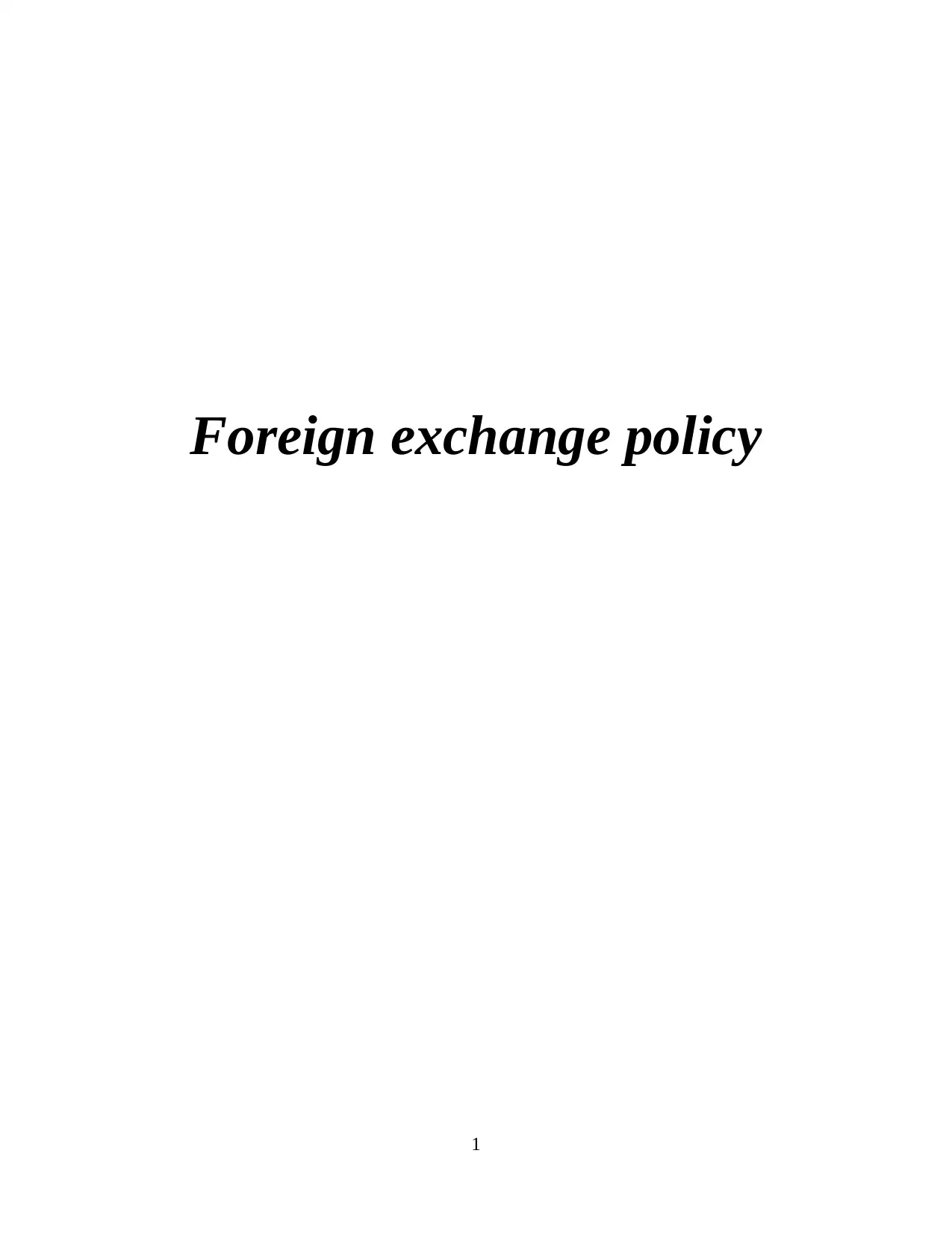
Foreign exchange policy
1
1
Paraphrase This Document
Need a fresh take? Get an instant paraphrase of this document with our AI Paraphraser
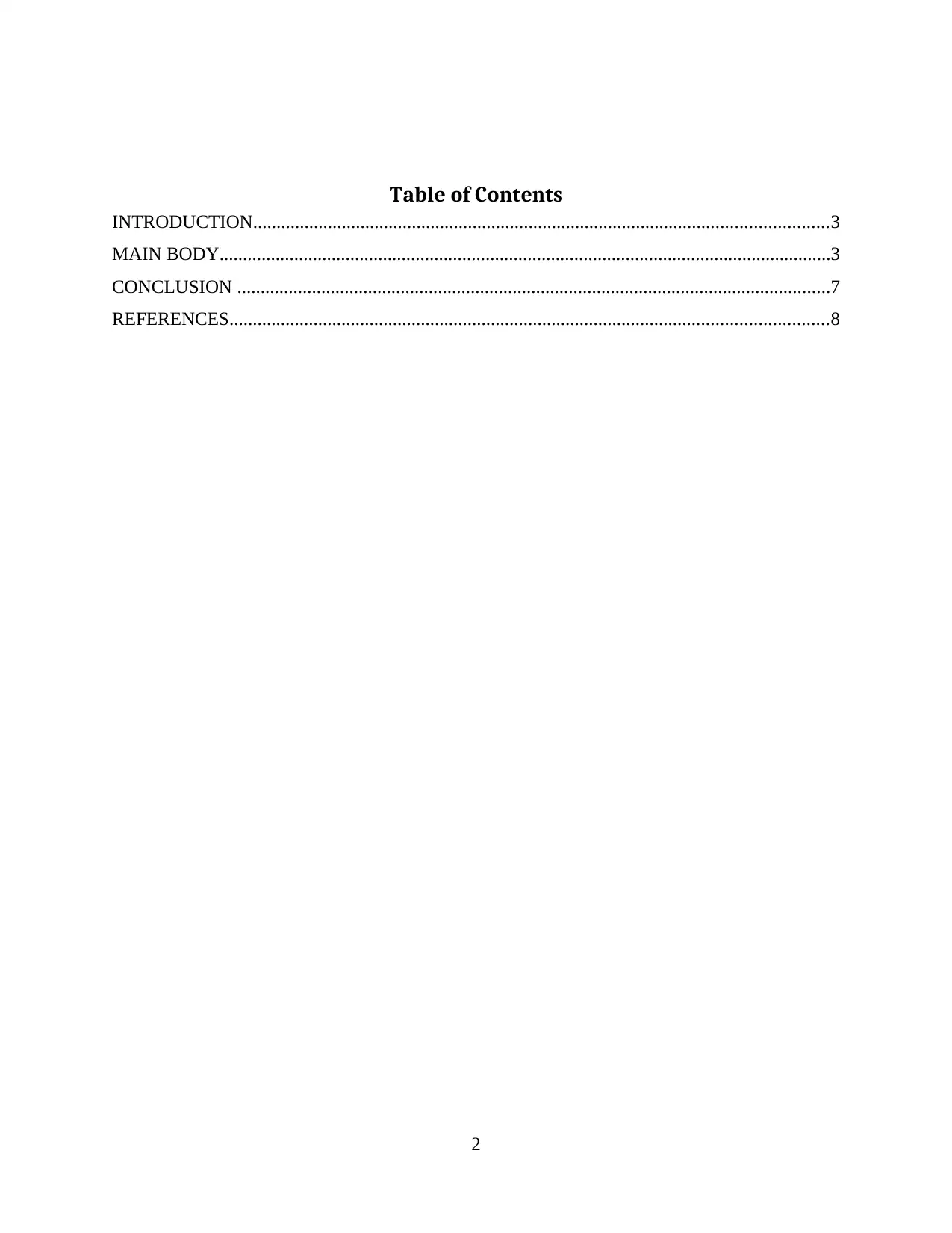
Table of Contents
INTRODUCTION...........................................................................................................................3
MAIN BODY...................................................................................................................................3
CONCLUSION ...............................................................................................................................7
REFERENCES................................................................................................................................8
2
INTRODUCTION...........................................................................................................................3
MAIN BODY...................................................................................................................................3
CONCLUSION ...............................................................................................................................7
REFERENCES................................................................................................................................8
2
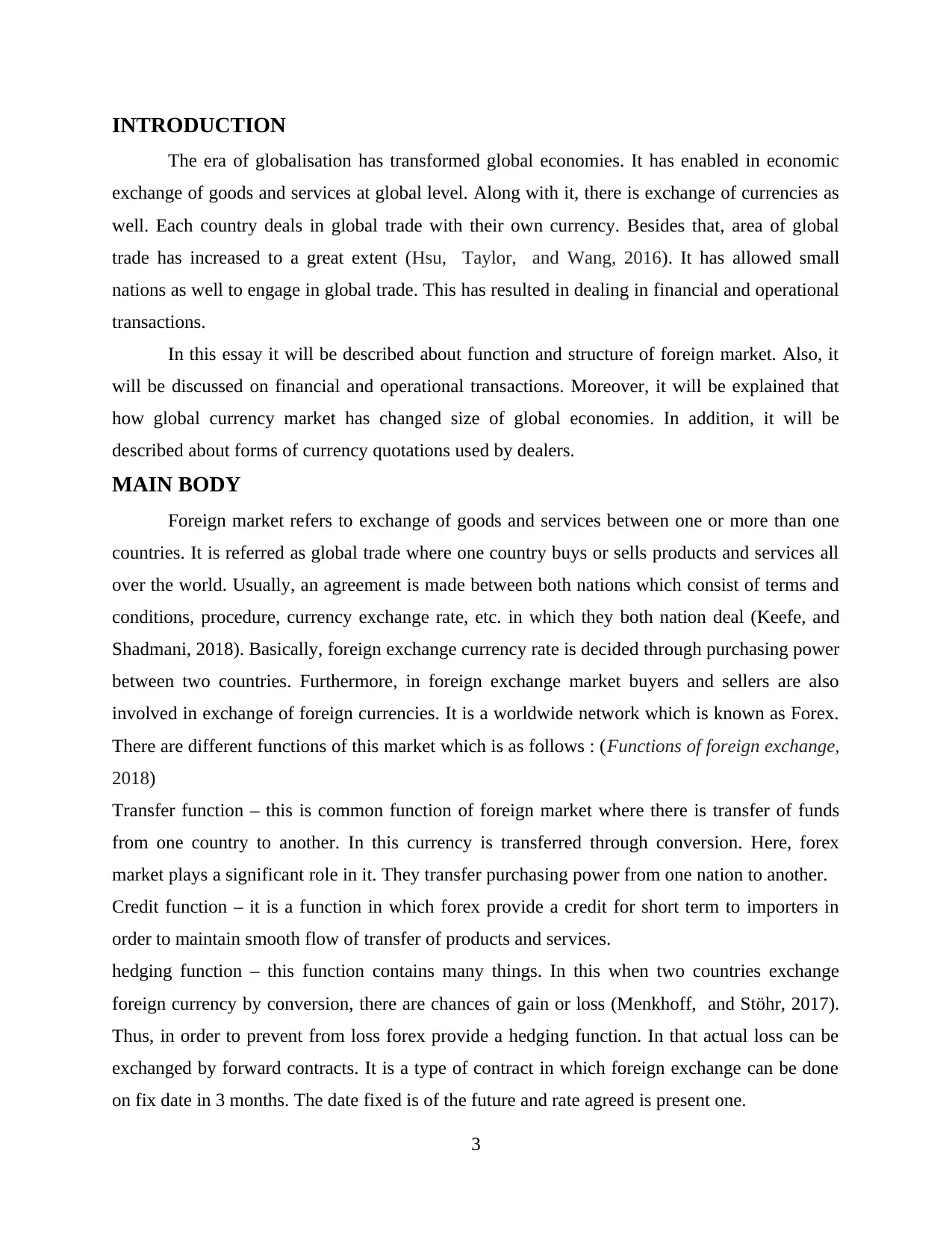
INTRODUCTION
The era of globalisation has transformed global economies. It has enabled in economic
exchange of goods and services at global level. Along with it, there is exchange of currencies as
well. Each country deals in global trade with their own currency. Besides that, area of global
trade has increased to a great extent (Hsu, Taylor, and Wang, 2016). It has allowed small
nations as well to engage in global trade. This has resulted in dealing in financial and operational
transactions.
In this essay it will be described about function and structure of foreign market. Also, it
will be discussed on financial and operational transactions. Moreover, it will be explained that
how global currency market has changed size of global economies. In addition, it will be
described about forms of currency quotations used by dealers.
MAIN BODY
Foreign market refers to exchange of goods and services between one or more than one
countries. It is referred as global trade where one country buys or sells products and services all
over the world. Usually, an agreement is made between both nations which consist of terms and
conditions, procedure, currency exchange rate, etc. in which they both nation deal (Keefe, and
Shadmani, 2018). Basically, foreign exchange currency rate is decided through purchasing power
between two countries. Furthermore, in foreign exchange market buyers and sellers are also
involved in exchange of foreign currencies. It is a worldwide network which is known as Forex.
There are different functions of this market which is as follows : (Functions of foreign exchange,
2018)
Transfer function – this is common function of foreign market where there is transfer of funds
from one country to another. In this currency is transferred through conversion. Here, forex
market plays a significant role in it. They transfer purchasing power from one nation to another.
Credit function – it is a function in which forex provide a credit for short term to importers in
order to maintain smooth flow of transfer of products and services.
hedging function – this function contains many things. In this when two countries exchange
foreign currency by conversion, there are chances of gain or loss (Menkhoff, and Stöhr, 2017).
Thus, in order to prevent from loss forex provide a hedging function. In that actual loss can be
exchanged by forward contracts. It is a type of contract in which foreign exchange can be done
on fix date in 3 months. The date fixed is of the future and rate agreed is present one.
3
The era of globalisation has transformed global economies. It has enabled in economic
exchange of goods and services at global level. Along with it, there is exchange of currencies as
well. Each country deals in global trade with their own currency. Besides that, area of global
trade has increased to a great extent (Hsu, Taylor, and Wang, 2016). It has allowed small
nations as well to engage in global trade. This has resulted in dealing in financial and operational
transactions.
In this essay it will be described about function and structure of foreign market. Also, it
will be discussed on financial and operational transactions. Moreover, it will be explained that
how global currency market has changed size of global economies. In addition, it will be
described about forms of currency quotations used by dealers.
MAIN BODY
Foreign market refers to exchange of goods and services between one or more than one
countries. It is referred as global trade where one country buys or sells products and services all
over the world. Usually, an agreement is made between both nations which consist of terms and
conditions, procedure, currency exchange rate, etc. in which they both nation deal (Keefe, and
Shadmani, 2018). Basically, foreign exchange currency rate is decided through purchasing power
between two countries. Furthermore, in foreign exchange market buyers and sellers are also
involved in exchange of foreign currencies. It is a worldwide network which is known as Forex.
There are different functions of this market which is as follows : (Functions of foreign exchange,
2018)
Transfer function – this is common function of foreign market where there is transfer of funds
from one country to another. In this currency is transferred through conversion. Here, forex
market plays a significant role in it. They transfer purchasing power from one nation to another.
Credit function – it is a function in which forex provide a credit for short term to importers in
order to maintain smooth flow of transfer of products and services.
hedging function – this function contains many things. In this when two countries exchange
foreign currency by conversion, there are chances of gain or loss (Menkhoff, and Stöhr, 2017).
Thus, in order to prevent from loss forex provide a hedging function. In that actual loss can be
exchanged by forward contracts. It is a type of contract in which foreign exchange can be done
on fix date in 3 months. The date fixed is of the future and rate agreed is present one.
3
⊘ This is a preview!⊘
Do you want full access?
Subscribe today to unlock all pages.

Trusted by 1+ million students worldwide
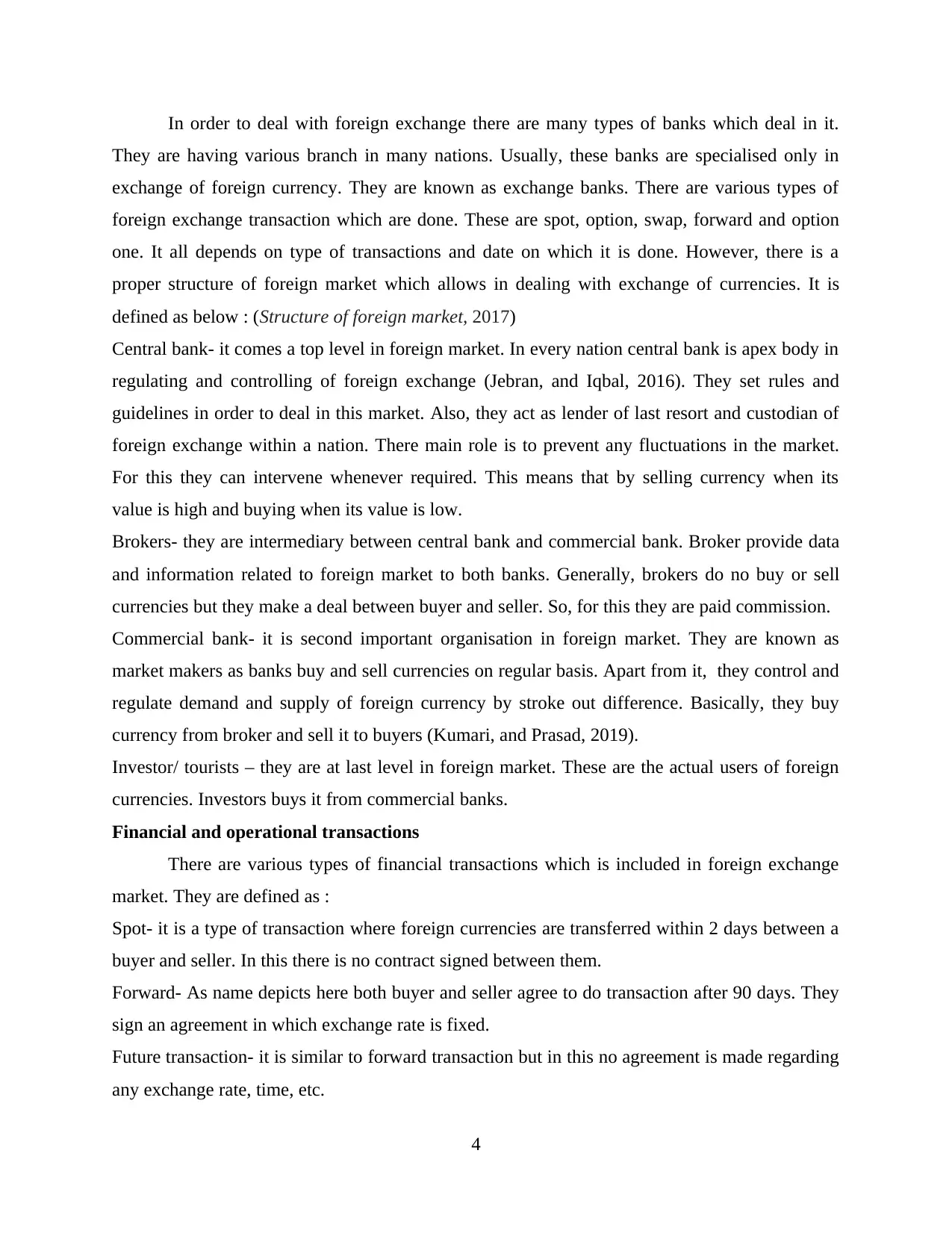
In order to deal with foreign exchange there are many types of banks which deal in it.
They are having various branch in many nations. Usually, these banks are specialised only in
exchange of foreign currency. They are known as exchange banks. There are various types of
foreign exchange transaction which are done. These are spot, option, swap, forward and option
one. It all depends on type of transactions and date on which it is done. However, there is a
proper structure of foreign market which allows in dealing with exchange of currencies. It is
defined as below : (Structure of foreign market, 2017)
Central bank- it comes a top level in foreign market. In every nation central bank is apex body in
regulating and controlling of foreign exchange (Jebran, and Iqbal, 2016). They set rules and
guidelines in order to deal in this market. Also, they act as lender of last resort and custodian of
foreign exchange within a nation. There main role is to prevent any fluctuations in the market.
For this they can intervene whenever required. This means that by selling currency when its
value is high and buying when its value is low.
Brokers- they are intermediary between central bank and commercial bank. Broker provide data
and information related to foreign market to both banks. Generally, brokers do no buy or sell
currencies but they make a deal between buyer and seller. So, for this they are paid commission.
Commercial bank- it is second important organisation in foreign market. They are known as
market makers as banks buy and sell currencies on regular basis. Apart from it, they control and
regulate demand and supply of foreign currency by stroke out difference. Basically, they buy
currency from broker and sell it to buyers (Kumari, and Prasad, 2019).
Investor/ tourists – they are at last level in foreign market. These are the actual users of foreign
currencies. Investors buys it from commercial banks.
Financial and operational transactions
There are various types of financial transactions which is included in foreign exchange
market. They are defined as :
Spot- it is a type of transaction where foreign currencies are transferred within 2 days between a
buyer and seller. In this there is no contract signed between them.
Forward- As name depicts here both buyer and seller agree to do transaction after 90 days. They
sign an agreement in which exchange rate is fixed.
Future transaction- it is similar to forward transaction but in this no agreement is made regarding
any exchange rate, time, etc.
4
They are having various branch in many nations. Usually, these banks are specialised only in
exchange of foreign currency. They are known as exchange banks. There are various types of
foreign exchange transaction which are done. These are spot, option, swap, forward and option
one. It all depends on type of transactions and date on which it is done. However, there is a
proper structure of foreign market which allows in dealing with exchange of currencies. It is
defined as below : (Structure of foreign market, 2017)
Central bank- it comes a top level in foreign market. In every nation central bank is apex body in
regulating and controlling of foreign exchange (Jebran, and Iqbal, 2016). They set rules and
guidelines in order to deal in this market. Also, they act as lender of last resort and custodian of
foreign exchange within a nation. There main role is to prevent any fluctuations in the market.
For this they can intervene whenever required. This means that by selling currency when its
value is high and buying when its value is low.
Brokers- they are intermediary between central bank and commercial bank. Broker provide data
and information related to foreign market to both banks. Generally, brokers do no buy or sell
currencies but they make a deal between buyer and seller. So, for this they are paid commission.
Commercial bank- it is second important organisation in foreign market. They are known as
market makers as banks buy and sell currencies on regular basis. Apart from it, they control and
regulate demand and supply of foreign currency by stroke out difference. Basically, they buy
currency from broker and sell it to buyers (Kumari, and Prasad, 2019).
Investor/ tourists – they are at last level in foreign market. These are the actual users of foreign
currencies. Investors buys it from commercial banks.
Financial and operational transactions
There are various types of financial transactions which is included in foreign exchange
market. They are defined as :
Spot- it is a type of transaction where foreign currencies are transferred within 2 days between a
buyer and seller. In this there is no contract signed between them.
Forward- As name depicts here both buyer and seller agree to do transaction after 90 days. They
sign an agreement in which exchange rate is fixed.
Future transaction- it is similar to forward transaction but in this no agreement is made regarding
any exchange rate, time, etc.
4
Paraphrase This Document
Need a fresh take? Get an instant paraphrase of this document with our AI Paraphraser
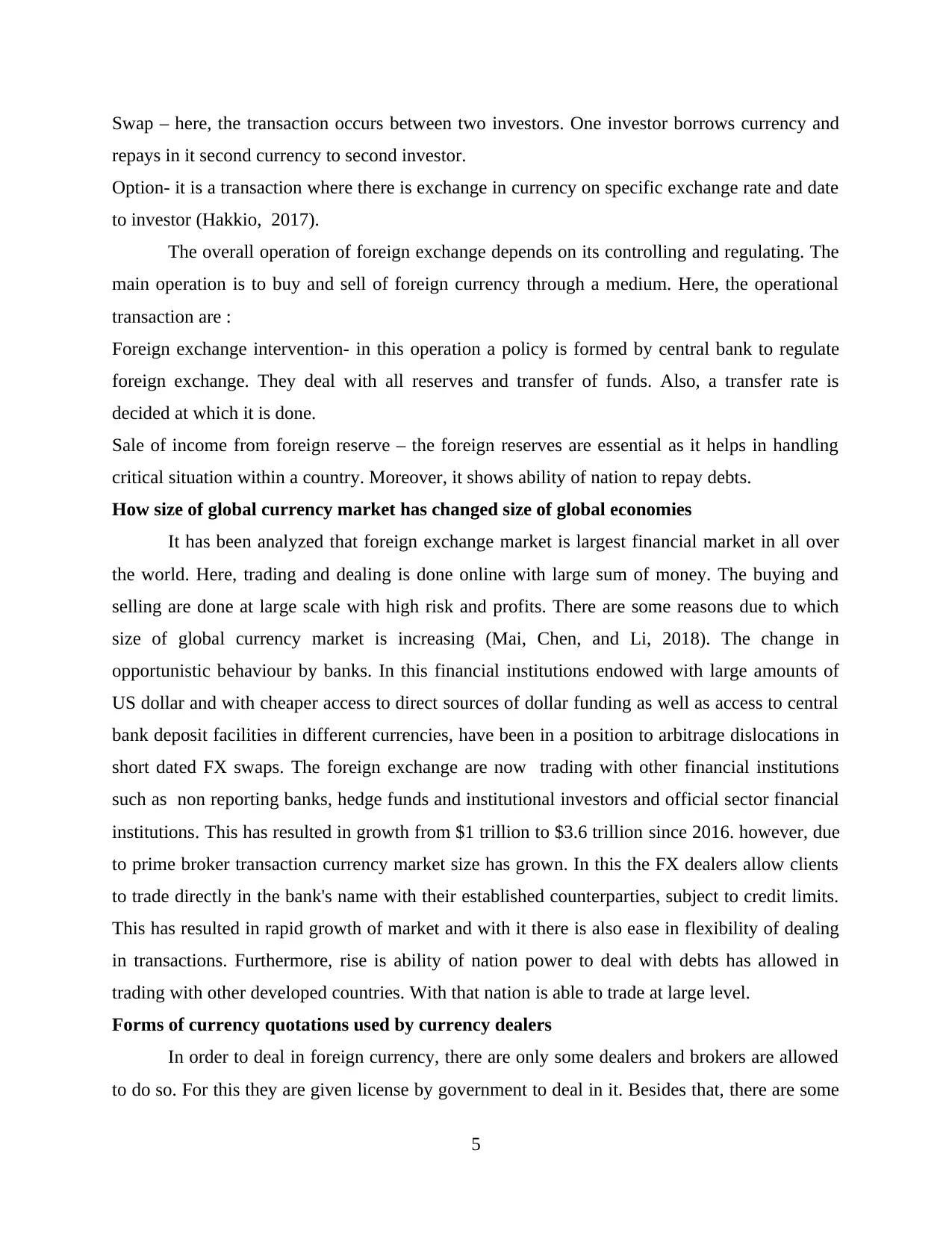
Swap – here, the transaction occurs between two investors. One investor borrows currency and
repays in it second currency to second investor.
Option- it is a transaction where there is exchange in currency on specific exchange rate and date
to investor (Hakkio, 2017).
The overall operation of foreign exchange depends on its controlling and regulating. The
main operation is to buy and sell of foreign currency through a medium. Here, the operational
transaction are :
Foreign exchange intervention- in this operation a policy is formed by central bank to regulate
foreign exchange. They deal with all reserves and transfer of funds. Also, a transfer rate is
decided at which it is done.
Sale of income from foreign reserve – the foreign reserves are essential as it helps in handling
critical situation within a country. Moreover, it shows ability of nation to repay debts.
How size of global currency market has changed size of global economies
It has been analyzed that foreign exchange market is largest financial market in all over
the world. Here, trading and dealing is done online with large sum of money. The buying and
selling are done at large scale with high risk and profits. There are some reasons due to which
size of global currency market is increasing (Mai, Chen, and Li, 2018). The change in
opportunistic behaviour by banks. In this financial institutions endowed with large amounts of
US dollar and with cheaper access to direct sources of dollar funding as well as access to central
bank deposit facilities in different currencies, have been in a position to arbitrage dislocations in
short dated FX swaps. The foreign exchange are now trading with other financial institutions
such as non reporting banks, hedge funds and institutional investors and official sector financial
institutions. This has resulted in growth from $1 trillion to $3.6 trillion since 2016. however, due
to prime broker transaction currency market size has grown. In this the FX dealers allow clients
to trade directly in the bank's name with their established counterparties, subject to credit limits.
This has resulted in rapid growth of market and with it there is also ease in flexibility of dealing
in transactions. Furthermore, rise is ability of nation power to deal with debts has allowed in
trading with other developed countries. With that nation is able to trade at large level.
Forms of currency quotations used by currency dealers
In order to deal in foreign currency, there are only some dealers and brokers are allowed
to do so. For this they are given license by government to deal in it. Besides that, there are some
5
repays in it second currency to second investor.
Option- it is a transaction where there is exchange in currency on specific exchange rate and date
to investor (Hakkio, 2017).
The overall operation of foreign exchange depends on its controlling and regulating. The
main operation is to buy and sell of foreign currency through a medium. Here, the operational
transaction are :
Foreign exchange intervention- in this operation a policy is formed by central bank to regulate
foreign exchange. They deal with all reserves and transfer of funds. Also, a transfer rate is
decided at which it is done.
Sale of income from foreign reserve – the foreign reserves are essential as it helps in handling
critical situation within a country. Moreover, it shows ability of nation to repay debts.
How size of global currency market has changed size of global economies
It has been analyzed that foreign exchange market is largest financial market in all over
the world. Here, trading and dealing is done online with large sum of money. The buying and
selling are done at large scale with high risk and profits. There are some reasons due to which
size of global currency market is increasing (Mai, Chen, and Li, 2018). The change in
opportunistic behaviour by banks. In this financial institutions endowed with large amounts of
US dollar and with cheaper access to direct sources of dollar funding as well as access to central
bank deposit facilities in different currencies, have been in a position to arbitrage dislocations in
short dated FX swaps. The foreign exchange are now trading with other financial institutions
such as non reporting banks, hedge funds and institutional investors and official sector financial
institutions. This has resulted in growth from $1 trillion to $3.6 trillion since 2016. however, due
to prime broker transaction currency market size has grown. In this the FX dealers allow clients
to trade directly in the bank's name with their established counterparties, subject to credit limits.
This has resulted in rapid growth of market and with it there is also ease in flexibility of dealing
in transactions. Furthermore, rise is ability of nation power to deal with debts has allowed in
trading with other developed countries. With that nation is able to trade at large level.
Forms of currency quotations used by currency dealers
In order to deal in foreign currency, there are only some dealers and brokers are allowed
to do so. For this they are given license by government to deal in it. Besides that, there are some
5
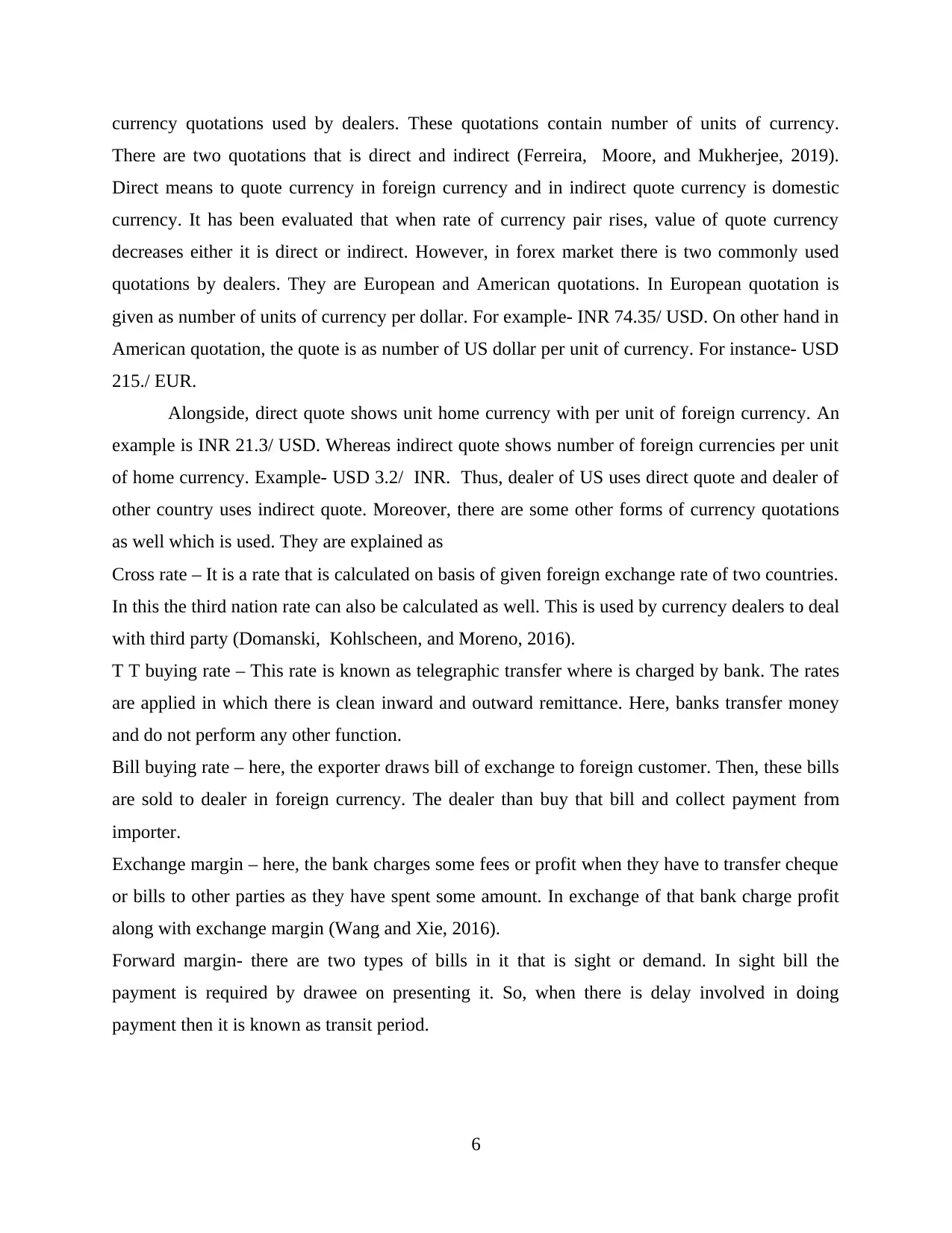
currency quotations used by dealers. These quotations contain number of units of currency.
There are two quotations that is direct and indirect (Ferreira, Moore, and Mukherjee, 2019).
Direct means to quote currency in foreign currency and in indirect quote currency is domestic
currency. It has been evaluated that when rate of currency pair rises, value of quote currency
decreases either it is direct or indirect. However, in forex market there is two commonly used
quotations by dealers. They are European and American quotations. In European quotation is
given as number of units of currency per dollar. For example- INR 74.35/ USD. On other hand in
American quotation, the quote is as number of US dollar per unit of currency. For instance- USD
215./ EUR.
Alongside, direct quote shows unit home currency with per unit of foreign currency. An
example is INR 21.3/ USD. Whereas indirect quote shows number of foreign currencies per unit
of home currency. Example- USD 3.2/ INR. Thus, dealer of US uses direct quote and dealer of
other country uses indirect quote. Moreover, there are some other forms of currency quotations
as well which is used. They are explained as
Cross rate – It is a rate that is calculated on basis of given foreign exchange rate of two countries.
In this the third nation rate can also be calculated as well. This is used by currency dealers to deal
with third party (Domanski, Kohlscheen, and Moreno, 2016).
T T buying rate – This rate is known as telegraphic transfer where is charged by bank. The rates
are applied in which there is clean inward and outward remittance. Here, banks transfer money
and do not perform any other function.
Bill buying rate – here, the exporter draws bill of exchange to foreign customer. Then, these bills
are sold to dealer in foreign currency. The dealer than buy that bill and collect payment from
importer.
Exchange margin – here, the bank charges some fees or profit when they have to transfer cheque
or bills to other parties as they have spent some amount. In exchange of that bank charge profit
along with exchange margin (Wang and Xie, 2016).
Forward margin- there are two types of bills in it that is sight or demand. In sight bill the
payment is required by drawee on presenting it. So, when there is delay involved in doing
payment then it is known as transit period.
6
There are two quotations that is direct and indirect (Ferreira, Moore, and Mukherjee, 2019).
Direct means to quote currency in foreign currency and in indirect quote currency is domestic
currency. It has been evaluated that when rate of currency pair rises, value of quote currency
decreases either it is direct or indirect. However, in forex market there is two commonly used
quotations by dealers. They are European and American quotations. In European quotation is
given as number of units of currency per dollar. For example- INR 74.35/ USD. On other hand in
American quotation, the quote is as number of US dollar per unit of currency. For instance- USD
215./ EUR.
Alongside, direct quote shows unit home currency with per unit of foreign currency. An
example is INR 21.3/ USD. Whereas indirect quote shows number of foreign currencies per unit
of home currency. Example- USD 3.2/ INR. Thus, dealer of US uses direct quote and dealer of
other country uses indirect quote. Moreover, there are some other forms of currency quotations
as well which is used. They are explained as
Cross rate – It is a rate that is calculated on basis of given foreign exchange rate of two countries.
In this the third nation rate can also be calculated as well. This is used by currency dealers to deal
with third party (Domanski, Kohlscheen, and Moreno, 2016).
T T buying rate – This rate is known as telegraphic transfer where is charged by bank. The rates
are applied in which there is clean inward and outward remittance. Here, banks transfer money
and do not perform any other function.
Bill buying rate – here, the exporter draws bill of exchange to foreign customer. Then, these bills
are sold to dealer in foreign currency. The dealer than buy that bill and collect payment from
importer.
Exchange margin – here, the bank charges some fees or profit when they have to transfer cheque
or bills to other parties as they have spent some amount. In exchange of that bank charge profit
along with exchange margin (Wang and Xie, 2016).
Forward margin- there are two types of bills in it that is sight or demand. In sight bill the
payment is required by drawee on presenting it. So, when there is delay involved in doing
payment then it is known as transit period.
6
⊘ This is a preview!⊘
Do you want full access?
Subscribe today to unlock all pages.

Trusted by 1+ million students worldwide
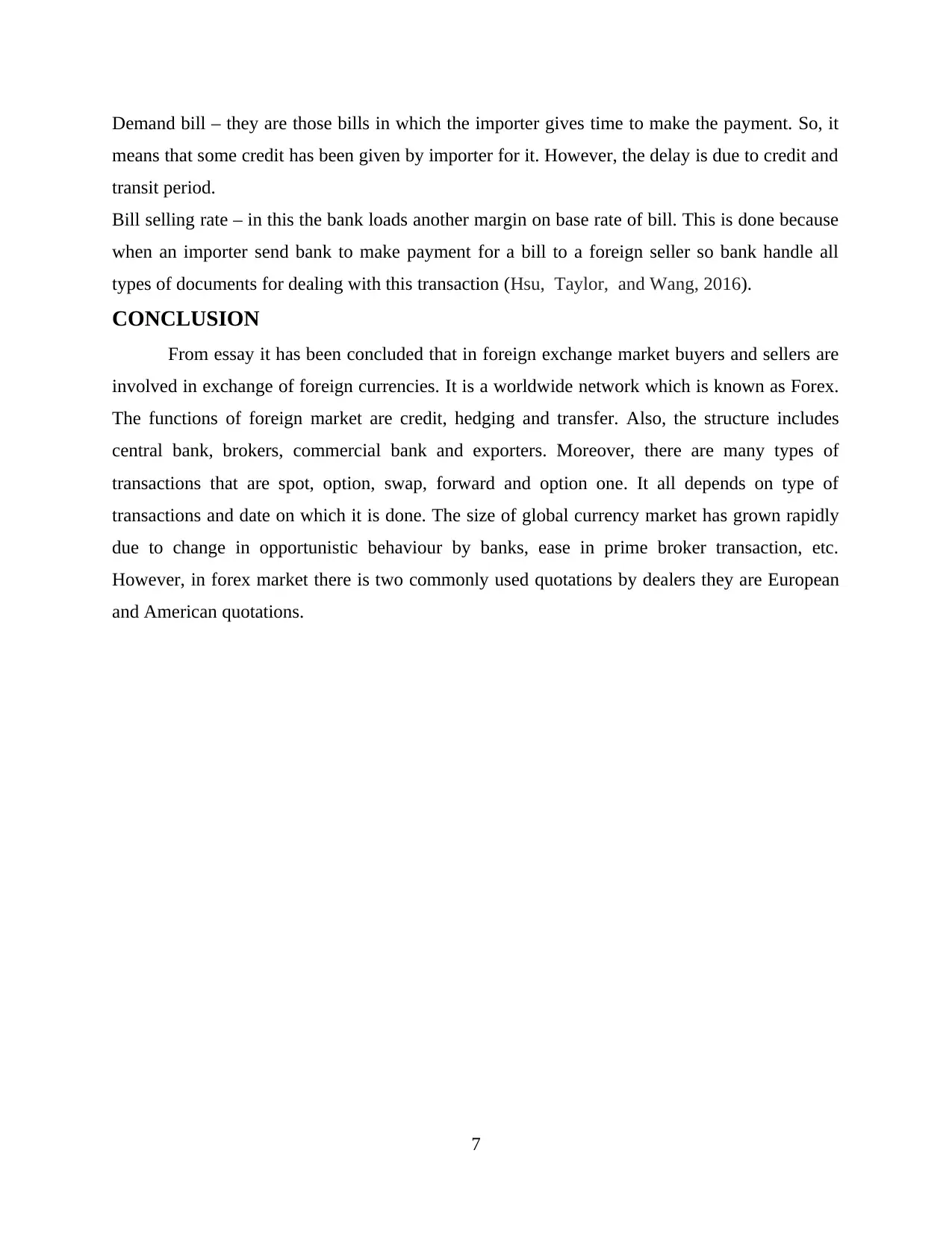
Demand bill – they are those bills in which the importer gives time to make the payment. So, it
means that some credit has been given by importer for it. However, the delay is due to credit and
transit period.
Bill selling rate – in this the bank loads another margin on base rate of bill. This is done because
when an importer send bank to make payment for a bill to a foreign seller so bank handle all
types of documents for dealing with this transaction (Hsu, Taylor, and Wang, 2016).
CONCLUSION
From essay it has been concluded that in foreign exchange market buyers and sellers are
involved in exchange of foreign currencies. It is a worldwide network which is known as Forex.
The functions of foreign market are credit, hedging and transfer. Also, the structure includes
central bank, brokers, commercial bank and exporters. Moreover, there are many types of
transactions that are spot, option, swap, forward and option one. It all depends on type of
transactions and date on which it is done. The size of global currency market has grown rapidly
due to change in opportunistic behaviour by banks, ease in prime broker transaction, etc.
However, in forex market there is two commonly used quotations by dealers they are European
and American quotations.
7
means that some credit has been given by importer for it. However, the delay is due to credit and
transit period.
Bill selling rate – in this the bank loads another margin on base rate of bill. This is done because
when an importer send bank to make payment for a bill to a foreign seller so bank handle all
types of documents for dealing with this transaction (Hsu, Taylor, and Wang, 2016).
CONCLUSION
From essay it has been concluded that in foreign exchange market buyers and sellers are
involved in exchange of foreign currencies. It is a worldwide network which is known as Forex.
The functions of foreign market are credit, hedging and transfer. Also, the structure includes
central bank, brokers, commercial bank and exporters. Moreover, there are many types of
transactions that are spot, option, swap, forward and option one. It all depends on type of
transactions and date on which it is done. The size of global currency market has grown rapidly
due to change in opportunistic behaviour by banks, ease in prime broker transaction, etc.
However, in forex market there is two commonly used quotations by dealers they are European
and American quotations.
7
Paraphrase This Document
Need a fresh take? Get an instant paraphrase of this document with our AI Paraphraser
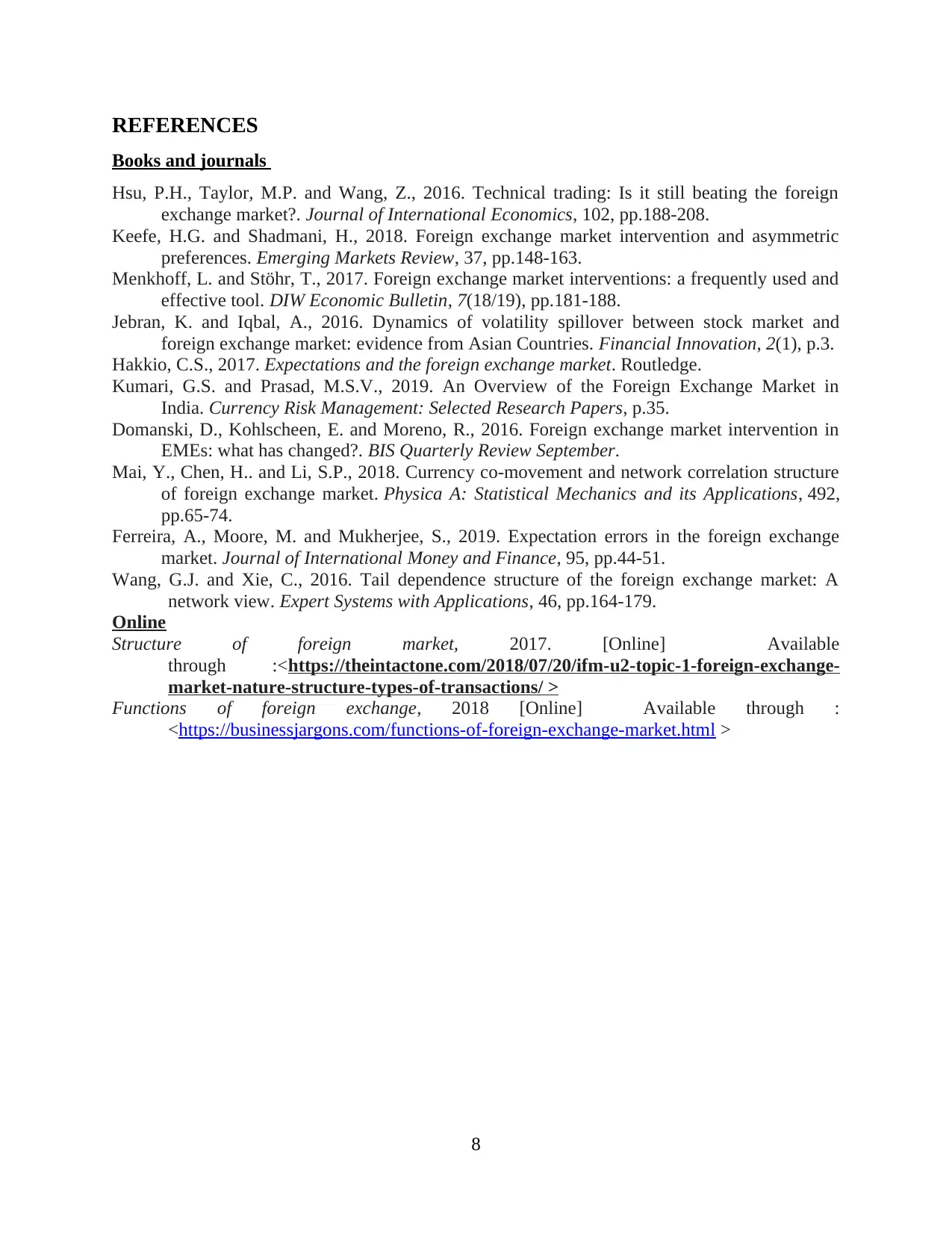
REFERENCES
Books and journals
Hsu, P.H., Taylor, M.P. and Wang, Z., 2016. Technical trading: Is it still beating the foreign
exchange market?. Journal of International Economics, 102, pp.188-208.
Keefe, H.G. and Shadmani, H., 2018. Foreign exchange market intervention and asymmetric
preferences. Emerging Markets Review, 37, pp.148-163.
Menkhoff, L. and Stöhr, T., 2017. Foreign exchange market interventions: a frequently used and
effective tool. DIW Economic Bulletin, 7(18/19), pp.181-188.
Jebran, K. and Iqbal, A., 2016. Dynamics of volatility spillover between stock market and
foreign exchange market: evidence from Asian Countries. Financial Innovation, 2(1), p.3.
Hakkio, C.S., 2017. Expectations and the foreign exchange market. Routledge.
Kumari, G.S. and Prasad, M.S.V., 2019. An Overview of the Foreign Exchange Market in
India. Currency Risk Management: Selected Research Papers, p.35.
Domanski, D., Kohlscheen, E. and Moreno, R., 2016. Foreign exchange market intervention in
EMEs: what has changed?. BIS Quarterly Review September.
Mai, Y., Chen, H.. and Li, S.P., 2018. Currency co-movement and network correlation structure
of foreign exchange market. Physica A: Statistical Mechanics and its Applications, 492,
pp.65-74.
Ferreira, A., Moore, M. and Mukherjee, S., 2019. Expectation errors in the foreign exchange
market. Journal of International Money and Finance, 95, pp.44-51.
Wang, G.J. and Xie, C., 2016. Tail dependence structure of the foreign exchange market: A
network view. Expert Systems with Applications, 46, pp.164-179.
Online
Structure of foreign market, 2017. [Online] Available
through :<https://theintactone.com/2018/07/20/ifm-u2-topic-1-foreign-exchange-
market-nature-structure-types-of-transactions/ >
Functions of foreign exchange, 2018 [Online] Available through :
<https://businessjargons.com/functions-of-foreign-exchange-market.html >
8
Books and journals
Hsu, P.H., Taylor, M.P. and Wang, Z., 2016. Technical trading: Is it still beating the foreign
exchange market?. Journal of International Economics, 102, pp.188-208.
Keefe, H.G. and Shadmani, H., 2018. Foreign exchange market intervention and asymmetric
preferences. Emerging Markets Review, 37, pp.148-163.
Menkhoff, L. and Stöhr, T., 2017. Foreign exchange market interventions: a frequently used and
effective tool. DIW Economic Bulletin, 7(18/19), pp.181-188.
Jebran, K. and Iqbal, A., 2016. Dynamics of volatility spillover between stock market and
foreign exchange market: evidence from Asian Countries. Financial Innovation, 2(1), p.3.
Hakkio, C.S., 2017. Expectations and the foreign exchange market. Routledge.
Kumari, G.S. and Prasad, M.S.V., 2019. An Overview of the Foreign Exchange Market in
India. Currency Risk Management: Selected Research Papers, p.35.
Domanski, D., Kohlscheen, E. and Moreno, R., 2016. Foreign exchange market intervention in
EMEs: what has changed?. BIS Quarterly Review September.
Mai, Y., Chen, H.. and Li, S.P., 2018. Currency co-movement and network correlation structure
of foreign exchange market. Physica A: Statistical Mechanics and its Applications, 492,
pp.65-74.
Ferreira, A., Moore, M. and Mukherjee, S., 2019. Expectation errors in the foreign exchange
market. Journal of International Money and Finance, 95, pp.44-51.
Wang, G.J. and Xie, C., 2016. Tail dependence structure of the foreign exchange market: A
network view. Expert Systems with Applications, 46, pp.164-179.
Online
Structure of foreign market, 2017. [Online] Available
through :<https://theintactone.com/2018/07/20/ifm-u2-topic-1-foreign-exchange-
market-nature-structure-types-of-transactions/ >
Functions of foreign exchange, 2018 [Online] Available through :
<https://businessjargons.com/functions-of-foreign-exchange-market.html >
8
1 out of 8
Related Documents
Your All-in-One AI-Powered Toolkit for Academic Success.
+13062052269
info@desklib.com
Available 24*7 on WhatsApp / Email
![[object Object]](/_next/static/media/star-bottom.7253800d.svg)
Unlock your academic potential
Copyright © 2020–2025 A2Z Services. All Rights Reserved. Developed and managed by ZUCOL.





